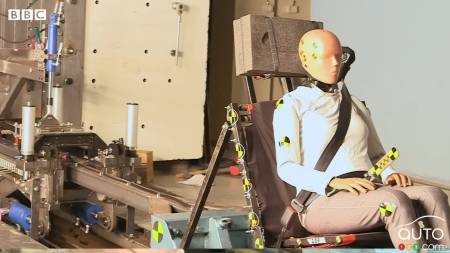• A Swedish team has designed a female crash test dummy that is more representative and allows for accurate data during collision testing.
• The new model better represents the female body type.
• According to the NHTSA, women are 73% more likely than men to be seriously injured in a car accident.
Since the early 1970s, the dummy type used in collision testing throughout the world has represented the average man (height, weight and proportion). That crash test dummy was created by GM and is known as the Hybrid 1.
When testers sought to collect data as it could apply to women, children and babies, the Hybrid 1 model was simply reduced in size. This was enough to get a general idea, but it was clear that more could be done.
The first crash test dummy model representing a woman was designed in 2011. The problem was that its specific body type was not very representative (corresponding to only 5 percent of women). The model was only 4 ft 11 in tall and weighed only 108 lb, the size of a young teenage girl. This crash test dummy is still in use today.
Browse cars for sale available near you
Obviously, some researchers wanted something better. The BBC recently reported on a team of Swedish researchers that has developed a mannequin that is much more representative of women.
The dummy is 5 ft 3 in tall and weighs 137 lb. In the United States, according to the CDC (Centers for Disease Control and Prevention), the average American woman stands 5 ft 4 in tall and weighs 170 lb, whereas in Europe, the average is 5 ft 5 in tall and 155 lb.
Just as importantly, the new model better represents women's breasts and hips, as well as being more in line with female biomass, i.e. with less mass, muscle strength and joint stiffness. This is of paramount importance in understanding the risks of potential injuries in crash tests.
Astrid Linder, an engineer and director of road safety at the Swedish National Institute for Transport Research, led the research team that developed the new dummy. She said the aspect of stiffness is particularly important because women are more likely than men to suffer whiplash injuries in low-severity accidents. His group found that the performance of different seats was very different for men and women.
A dummy that better represents women will provide more accurate data on injury risk once airbags are deployed. Their position close to the steering wheel can be better assessed, including the performance of the seat belts on their bodies.
The creation of the new dummy is only the first step. Further studies and analysis will be required. Authorities in various countries will also have to approve the dummy before it can be used. However, if the data is conclusive, it should only be a matter of time.
The following data shows how necessary the development of a woman-representative crash test dummy was. According to the National Highway Traffic Safety Administration (NHTSA), women are 73 percent more likely than men to be seriously injured in a car accident. In 2021, the Insurance Institute for Highway Safety (IIHS) studied crash reports spanning 18 years. After subtracting differences in vehicle size, it found that “women were still twice as likely to be moderately injured and a bit more likely to be seriously hurt”, as well as being 2.5 times more likely to suffer moderate leg injuries.



